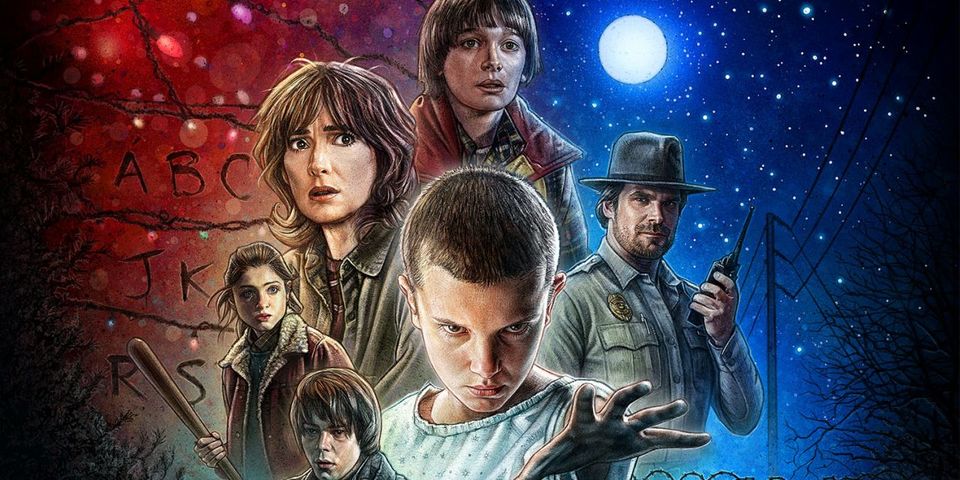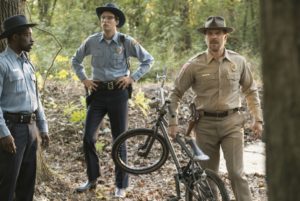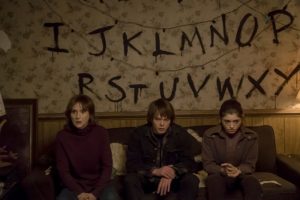The following review endeavors to be as spoiler-free as possible. Obviously, however, there is some discussion of plot and character elements. If you’ve already decided to watch the show and want to go in as fresh as possible, maybe save this review until after the fact.
Netflix, by this point, has well-established itself in the original programming department. From flagship programs like House of Cards and Orange is the New Black, to more esoteric shows like Sense8 or Hemlock Grove, Netflix’s shows run the gamut in both genre and quality. Its latest effort, Stranger Things, which premiered Friday, July 15th, was announced out of the blue a month ago, promising a nostalgia-driven science-fiction/horror drama set in the eighties. The trailer evoked the adventure and innocence of ‘80s adventure films like E.T. or The Goonies, as well as the harder edge of classic horror fare like The Thing or The Evil Dead. The show stars Winona Ryder and Matthew Modine — stars emblematic of the eighties — alongside an ensemble of relative unknowns, in a story of a small town besieged by mysterious disappearances, bizarre occurrences, and shady government operatives. It is created, produced, and many of its episodes written and directed by Matt & Ross Duffer, The Duffer Brothers. Two more relative unknowns, the brothers are probably best known for working on the Fox series Wayward Pines.
The trailer generated a lot of excitement, not only due to the fact that Netflix had stealthily made this show without hardly anyone hearing about it, but for the promise of its intoxicating blend of sci-fi, horror, and ‘80s paranoia. Does the eight-episode series live up to that promise, or is it just another empty vessel for self-indulgent nostalgia?
“I always figured there was enough going on down here, there was no need to look elsewhere.”
If you were trying to describe Stranger Things to someone, you might say it was Freaks & Geeks meets Firestarter. Meets Pan’s Labyrinth. Meets E.T.. Meets Beyond The Black Rainbow. Meets meets meets. The list of references and homages in this series is as long as my arm. Suffice it to say, the plot revolves around the disappearance of a young boy, Will Beyers, in a small Indiana town in 1983. Will’s mother (Ryder) goes into a frenzy, and soon the whole town is out looking for him, to no avail. Meanwhile, Will’s disappearance coincides with the appearance of a strange girl of about the same age, whose head is shaved, who barely speaks, and who identifies herself only as “Eleven.” Pursued by sinister government scientists (led by Modine), Eleven takes refuge with Will’s friends, and bit by bit the mystery begins to reveal itself. Mixed in with all these sci-fi and horror elements is a healthy dose of adolescent angst, teen romance and betrayal, and a warm nostalgia for the era the show is set in.
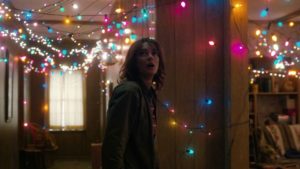 If this all sounds familiar, it is; there’s very little here which hasn’t been seen before. Fortunately, Stranger Things is greater than the sum of its parts. It transcends being a mere homage and remix of all the horror and science-fiction films you loved from the seventies and eighties, and manages to weave them together in an exciting, frightening, and emotionally resonant way. The references (often directly called out, either in dialogue or via movie posters hanging in the background: Jaws, The Evil Dead, The Thing, etc.) are not the point of the show; this isn’t Family Guy. They’re simply a tool in the Duffer Brothers’ toolkit, used as a storytelling device the same as cinematography or dialogue, and it’s a credit to the Duffer Brothers’ restraint that they rarely become distracting. The focus here isn’t the nostalgia, or even the government conspiracy/monster. It’s the characters. The show follows essentially three generations of characters searching for the missing boy: There’s Will’s mother, Joyce, and the town sheriff, Jim “Hopp” Hopper; the former of whom thinks her son is “talking” to her through the lights in her house, the latter of whom has suffered a loss of his own. There’s the boy’s friends, Mike, Dustin, and Lucas, a trio of nerdy boys who relate to the world best when they’re comparing it to their Dungeons & Dragons campaigns. And there’s Will’s older brother Jonathan, a social outcast who finds an unlikely ally in Mike’s older sister Nancy. The disparate threads of these different characters’ storylines are woven throughout the show’s eight hours, with the threat of Modine and his pack of government thugs looming over them all, and the horror and sci-fi elements creeping ever closer to the foreground. The show is well-plotted and paced, and the dialogue is sharp, charming, and entirely believable. Mike, Dustin, and Lucas are a hoot, both when they’re squabbling amongst themselves in the nerdiest ways possible, and when they’re trying to teach the mysterious Eleven about small-town life and social mores. Karen’s budding romance with a handsome, popular boy at school, and Jonathan’s increasing distrust of the boy, wouldn’t feel out of place in a John Hughes film, and that’s meant in the most positive way that can be taken. Meanwhile, Hobb’s quiet determination to find the missing kid is a wonderful counterpoint to Joyce’s building hysteria — the hysteria of a woman who knows her son is alive but who nobody believes, not until it might be too late to do anything.
If this all sounds familiar, it is; there’s very little here which hasn’t been seen before. Fortunately, Stranger Things is greater than the sum of its parts. It transcends being a mere homage and remix of all the horror and science-fiction films you loved from the seventies and eighties, and manages to weave them together in an exciting, frightening, and emotionally resonant way. The references (often directly called out, either in dialogue or via movie posters hanging in the background: Jaws, The Evil Dead, The Thing, etc.) are not the point of the show; this isn’t Family Guy. They’re simply a tool in the Duffer Brothers’ toolkit, used as a storytelling device the same as cinematography or dialogue, and it’s a credit to the Duffer Brothers’ restraint that they rarely become distracting. The focus here isn’t the nostalgia, or even the government conspiracy/monster. It’s the characters. The show follows essentially three generations of characters searching for the missing boy: There’s Will’s mother, Joyce, and the town sheriff, Jim “Hopp” Hopper; the former of whom thinks her son is “talking” to her through the lights in her house, the latter of whom has suffered a loss of his own. There’s the boy’s friends, Mike, Dustin, and Lucas, a trio of nerdy boys who relate to the world best when they’re comparing it to their Dungeons & Dragons campaigns. And there’s Will’s older brother Jonathan, a social outcast who finds an unlikely ally in Mike’s older sister Nancy. The disparate threads of these different characters’ storylines are woven throughout the show’s eight hours, with the threat of Modine and his pack of government thugs looming over them all, and the horror and sci-fi elements creeping ever closer to the foreground. The show is well-plotted and paced, and the dialogue is sharp, charming, and entirely believable. Mike, Dustin, and Lucas are a hoot, both when they’re squabbling amongst themselves in the nerdiest ways possible, and when they’re trying to teach the mysterious Eleven about small-town life and social mores. Karen’s budding romance with a handsome, popular boy at school, and Jonathan’s increasing distrust of the boy, wouldn’t feel out of place in a John Hughes film, and that’s meant in the most positive way that can be taken. Meanwhile, Hobb’s quiet determination to find the missing kid is a wonderful counterpoint to Joyce’s building hysteria — the hysteria of a woman who knows her son is alive but who nobody believes, not until it might be too late to do anything.
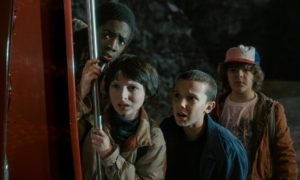 The acting, to my surprise, was almost universally strong. Ryder and Modine may be the only “names” in the cast, but everyone acquits themselves admirably, even — and especially — the child actors. The actors playing Mike, Dustin, and Lucas have an earnestness, and a real rapport with each other, that never seems forced, and Millie Bobbie Brown as Eleven is nothing short of a revelation. David Harbour (The Newsroom, State of Affairs) brings a quiet, but powerful, emotional resonance to Chief Jim Hopper, and the teens are all convincing in their respective roles, as well. Modine isn’t given much to do, but he makes the most of it, going quieter and more menacing than I’ve seen him do before, and the result is genuinely chilling. Ryder’s taken some flack for her performance as Joyce, but I think her mounting hysteria over the loss of her child is appropriate in its pitch and tenor. Ryder’s given very little opportunity here to play a mother not frantically searching for her son, and even in the small glimpses of her we get in flashback, she’s still a generally harried and overworked individual. No, I’d say Ryder performs admirably here, as does the bulk of the rest of the cast.
The acting, to my surprise, was almost universally strong. Ryder and Modine may be the only “names” in the cast, but everyone acquits themselves admirably, even — and especially — the child actors. The actors playing Mike, Dustin, and Lucas have an earnestness, and a real rapport with each other, that never seems forced, and Millie Bobbie Brown as Eleven is nothing short of a revelation. David Harbour (The Newsroom, State of Affairs) brings a quiet, but powerful, emotional resonance to Chief Jim Hopper, and the teens are all convincing in their respective roles, as well. Modine isn’t given much to do, but he makes the most of it, going quieter and more menacing than I’ve seen him do before, and the result is genuinely chilling. Ryder’s taken some flack for her performance as Joyce, but I think her mounting hysteria over the loss of her child is appropriate in its pitch and tenor. Ryder’s given very little opportunity here to play a mother not frantically searching for her son, and even in the small glimpses of her we get in flashback, she’s still a generally harried and overworked individual. No, I’d say Ryder performs admirably here, as does the bulk of the rest of the cast.
The show looks and sounds good, too. It was shot on RED cameras, with an era-appropriate grain texture added in post-production, which doesn’t look quite as good as real film would have, but comes close. The geography of the town is never really made clear — where the homes are in relation to the school, in relation to the woods, in relation to the government lab, etc. — but it’s shot wonderfully, with both bleak blues and greys, and warmer yellows and browns, depending on where the scene takes place and what’s happening in it. There are some excellent practical effects, and some regrettable computer-generated ones — I don’t know what kind of budget Netflix has for these shows, but I’m guessing the bulk of this one went towards all the ‘80s set dressing, clothes, cars, etc. Fortunately the CGI stuff only pops in occasionally, and doesn’t distract too much from what’s going on. There’s a nice use of surround sound, particularly in the many scenes set in the woods, with rustling leaves and snapping branches seeming to come from all around you. There are also some nice atmospheric effects in the “bathtub” scene of episode seven, and during the climactic moments of episode eight. The score — a wonderful Carpenter-esque synth score from Kyle Dixon & Michael Stein which sets the mood perfectly — also creeps into the rear channels from time to time as well, to excellent effect.
If I had a complaint, it would be that the show doesn’t make much thematic use of its setting. The 1983 setting seems mostly to be there for ambiance — People smoke indoors! The phone connects to the wall! The kids ride their bikes alone at night! — but there’s little substance to it. I would have liked to have seen the show go deeper into the fear and paranoia which gripped the era; aside from a few mentions of “commies” and government experiments, it almost never comes up. Perhaps if the show gets a second season they can make better hay out of the time frame they’re playing with.
And I do sorely hope the show gets a second season. This show was spellbinding from start to finish; at turns frightening, emotional, thrilling, and hilarious. The plot was skillfully managed, and the dialogue sharp. The cinematography and period-specific mise-en-scene were gorgeous to look at. The “mythology” of the monster and the government experiments is hinted at, but is neither over-explained, nor so oblique as to be obnoxious. The characters felt real, and their emotional arcs held real weight. And the performances were all genuine and powerful — even considering this is a group of largely unknown, largely pre-pubescent, performers. The CG isn’t great, but it’s infrequent enough not to be a big deal. In all, this was a fantastic series; the Duffer Brothers now have my complete attention, whatever they may turn their talents towards next. Stranger Things gets my highest recommendation.

